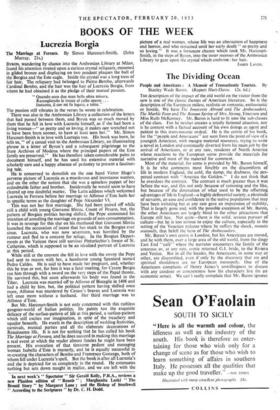BOOKS OF THE WEEK
Lucrezia Borgia
The Marriage at Ferrara. By Simon Harcourt-Smith. (John Murray. 21s.) BYRON, wandering by chalice into the Ambrosian Library at Milan, found his attention riveted upon a curious crystal reliquary, mounted in gilded bronze and displaying on two pendant plaquesthe bull of the Borgias and the Este eagle. Inside the crystal was a long tress of fair hair. The reliquary had belonged to Pietro.Bembo, afterwards Cardinal Bembo, and the hair was the hair of Lucrezia Borgia, from whom he had obtained it as the pledge of their mutual passion.
" Quando ecco due man belle okra misura, Raccogliendo le trecce al cob o sparse ...
Instanto, il cor ii fu legato, e tolto."
The passion still vibrates in the verses he wrote in celebration.
There was also in the Ambrosian Library a collection of the letters that had passed between them, and Byron was so much moved by them that he fell in love with Lucrezia himself, as if she had been a living woman—" so pretty and so loving, it makes rate wretched not to have been born sooner, to have at least seen her." Mr. Simon Harcourt-Smith is in love with Lucregia too. His book was born, he tells us," of a casual visit to the Ambrosian Library, an illuminating phrase in a letter of Byron's and a subsequent pilgrimage to the State Archives of Modena where the principal papers of the Este family are preserved." Helms therefore taken considerable pains to document himself, and he has used his extensive material with scholarly care and a happy absence of pedantry to present a fascinat- ing tale. - He. is concerned to demolish on the one hand Victor Hugo's perverse picture of Lucrezia as a murderous and incestuous wanton, and on the other the notion that she was a spineless puppet of her redoubtable father and brother. Incidentally he would seem to have cleared up one doubtful matter. The Latin address which welcomed Lucrezia to Ferrara before her marriage to Alfonso d'Este hails her in specific terms as the daughter of Pope Alexander VI. This was not her first marriage. She had been paired off while still a child with young Giovanni Sforza, Count of Pesaro, but, the pattern of Borgian politics having shifted, the Pope announced his intention of annulling the marriage on grounds of non-consummation. It was in revenge for this slur on his manhood that Giovanni Sforza launched the accusation of incest that has stuck to the Borgias ever since. Lucrezia, who was now seventeen, was horrified by the rumour and fled to a conyent for refuge. In the Borgian Depart- ments at the Vatican there still survives Pinturicchio's fresco of St. Catherine, which is supposed to be an idealised portrait of Lucrezia at this period. While still at the convent she fell in love with the envoy the Pope had sent to reason with her, a handsome young Spaniard named Pedro Caldes. He is said to have made her pregnant, and, whether this be true or not, for him it was a fatal meeting, for Cesare Borgia ran him through with a sword on the very steps of the Papal throne. He survived this, but soon afterwards his body was found in the Tiber. Lucrezia was married off to Alfonso of Biseeglie in 1498 and had a child by him, but, the political pattern having shifted once more, Alfonso was murdered by Cesare 's bravos and Lucrezia was left once more without a husband. Her third marriage was to Alfonso d'Este.
But Mr. Harcourt-Smith is not only concerned with this ruthless gangster-world of Italian politics. He paints too the exquisite delicacy of the surface-pattern of life at this period, a surface-pattern which still excites our imagination, in spite of the treachery and squalor beneath. He excels in the description of wedding festivities, carnivals, musical parties and all the elaborate decorations of Renaissance life. It is not for nothing that he has called his book The Marriage at Ferrara, and he does succeed in making this marriage a real event at which the reader almost fancies he might have been present. His evocation of that tiresome pedant and managing woman Isabella d'Este is masterly, and he is equally successful in re-creating the characters of Bembo and Francesco Gonzaga, both of whom fell under Lucrezia's spell. But the book is after all Lucrezia's and she is depicted for us completely in the round. He extenuates nothing but sets down naught in malice, and we are left with the picture of a real woman, whose life was an alternation of happiness and horror, and who remained until her early death" so pretty and so loving." It was a fortunate chance which took Mr. Harcourt- Smith, in the steps of Byron, into the inner recesses of the Ambrosian Library to gaze upon the crystal which enshrine; her hair.
JAMES LAVER.


































 Previous page
Previous page